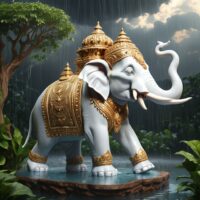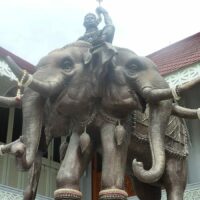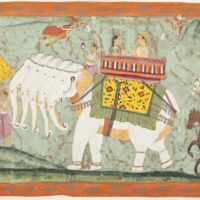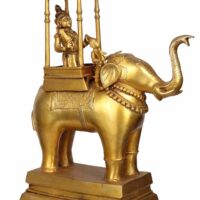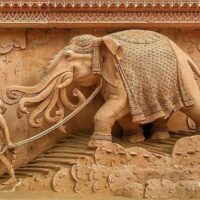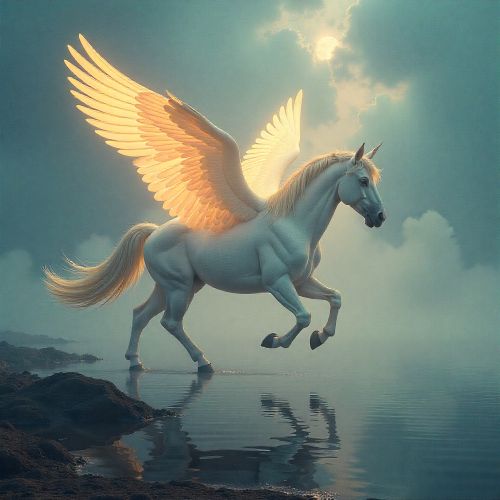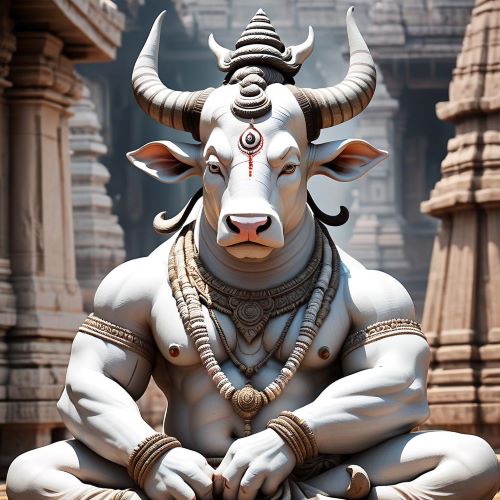Airavata : The White Elephant
Listen
At a glance
| Description | |
|---|---|
| Origin | Indian Mythology |
| Classification | Animals |
| Family Members | Iravati (Mother), Abhramu (Wife) |
| Region | Indian, Indonesia, Malaysia, Cambodia |
| Associated With | Indra, Clouds |
Airavata
Introduction
Indian mythology is filled with awe-inspiring figures, each carrying deep symbolic meaning. Among them, Airavata, the magnificent white elephant, holds a special place. As Indra’s vahana (mount), this celestial being represents strength, purity, and divine power. Its presence is woven through ancient texts like the Rigveda, Mahabharata, and various Puranas, highlighting its enduring significance.
Airavata’s origins trace back to the churning of the ocean (Samudra Manthan), a pivotal cosmic event. From this turmoil, the divine elephant emerged and was chosen by Indra, reinforcing the god’s status and authority. More than just a vehicle, Airavata plays an active role in celestial affairs, embodying Indra’s might while remaining a revered figure in mythology.
Physical Traits
Airavata is portrayed as a majestic white elephant, its luminous form symbolizing purity and divine energy. Different texts offer varied descriptions—some depict it with multiple heads, ranging from three to thirty-three, while others mention four tusks or even ten. These features emphasize its immense power and its role in safeguarding all directions, much like Indra himself.
Certain accounts link Airavata’s radiant white color to its long immersion in the ocean of milk. Emerging from the cosmic churning (Samudra Manthan), it became one of the celestial treasures bestowed upon the gods. Its enormous form effortlessly carries Indra and his thunderbolt, Vajra, while its powerful trunk, reaching the skies, is said to bring rain, reinforcing its connection to water, fertility, and abundance.
Family
Airavata’s origins vary across Hindu scriptures, with some texts naming Iravati, a celestial river goddess, as its mother, while others suggest it descends from Bhadramana or sage Kashyapa’s lineage. It is also counted among the Diggajas, a group of divine elephants guarding the cardinal directions, reinforcing its cosmic role in maintaining balance.
Airavata’s consort, Abhramu, is often linked to clouds and rain, emphasizing their shared connection to fertility and abundance. Together, they are believed to nurture life on earth, symbolizing prosperity. Some legends also describe them as the ancestors of white-winged elephants, adding another layer of mystique to Airavata’s legacy. In Jain traditions, Airavata is associated with specific regions of Jambudvipa, demonstrating its presence across different religious narratives.
Other names
Airavata is known by many names, each highlighting a different aspect of its divine nature. Abhra-Matanga, meaning “elephant of the clouds,” reflects its connection to rain and storms, while Naga-Malla, or “battle elephant,” emphasizes its strength and warrior-like presence. The name Arkasodara, translating to “brother of the sun,” links Airavata to divine radiance, and Shwethasti, meaning “the white one,” underscores its purity. In Thai tradition, it is called Erawan, demonstrating its cultural influence beyond India. Another title, Gajrajagrani, meaning “king of elephants,” reinforces its supreme status among celestial beings. These epithets collectively capture Airavata’s role in mythology as a powerful, revered, and cosmic force.
Powers and Abilities
Airavata is not only Indra’s celestial mount but also a powerful force in mythology. Known for its immense strength and speed, it can traverse between the heavens and the earth with ease. One of its most remarkable abilities is drawing water from the underworld with its trunk and releasing it into the sky, a process that brings life-giving rain. This connection to water solidifies its role in fertility, abundance, and sustenance.
As a guardian of the cardinal directions, Airavata plays a crucial role in maintaining cosmic balance. Its presence is said to summon rains with its thunderous trumpeting, while the movement of its massive ears creates fragrant breezes. Beyond its role in mythology, Airavata’s image holds deep cultural and spiritual significance, influencing rituals and symbolizing prosperity. The white elephant is often associated with good fortune, and its connection to rain makes it particularly revered in agricultural traditions.
Modern Day Influence
Airavata’s legacy extends far beyond ancient scriptures, shaping modern art, culture, and symbolism in profound ways. In Hindu iconography, he is often portrayed as a grand white elephant adorned with celestial ornaments, embodying power, wisdom, and divine grace. Temples across India and Southeast Asia feature intricate carvings of Airavata, with the Airavatesvara Temple in Tamil Nadu standing as a prime example of his enduring reverence.
In Thailand and Cambodia, Airavata—known as Erawan—holds deep cultural significance, symbolizing royal authority and protection. The Erawan Shrine in Bangkok remains a revered site, where devotees seek blessings for prosperity and good fortune. His influence extends into contemporary design, where his imagery appears in corporate logos, fashion, and architecture, reflecting qualities of intelligence, stability, and reliability.
Beyond religious and artistic representations, Airavata has also found a place in popular culture. He is featured in literature, films, and video games as a symbol of strength and nobility. The Karnataka State Road Transport Corporation named its Volvo bus service after him, reinforcing his association with grandeur and reliability. Even in ecological discussions, the white elephant serves as a metaphor for conservation, emphasizing the importance of preserving endangered species.
Airavata’s presence across time and cultures underscores his timeless influence. From ancient texts to modern media, he remains a powerful symbol of strength, purity, and divine connection, inspiring generations across the world.
Related Images
Source
“Airavata,” Ancient History Encyclopedia. Accessed at .
“Hindu Mythology,” Encyclopaedia Britannica Online. Available at .
“Airavata and the Diggajas,” Hindu Mythological Stories. Accessed via .
Ali Javid; ʻAlī Jāvīd; Tabassum Javeed. (2008). World Heritage Monuments and Related Edifices in India. Algora Publishing.
Dalal, Roshen. (2010). Hinduism: An Alphabetical Guide. Penguin Books India.
Dowson, John. (1870). A Classical Dictionary of Hindu Mythology and Religion, Geography, History, and Literature. London: Trübner & Company.
Ganguli, Kishori Mohan. “SECTION XXXV”. Mahabharata. Pratap Chandra Babu.
Gopal, Madan (1990). K.S. Gautam (ed.). India through the ages. Publication Division, Ministry of Information and Broadcasting, Government of India.
Goswamy, B. N. (2014), The Spirit of Indian Painting: Close Encounters with 100 Great Works 1100–1900, Penguin Books.
Frequently Asked Questions
What is lorem Ipsum?
I am text block. Click edit button to change this text. Lorem ipsum dolor sit amet, consectetur adipiscing elit. Ut elit tellus, luctus nec ullamcorper mattis, pulvinar dapibus leo.
What is lorem Ipsum?
I am text block. Click edit button to change this text. Lorem ipsum dolor sit amet, consectetur adipiscing elit. Ut elit tellus, luctus nec ullamcorper mattis, pulvinar dapibus leo.
What is lorem Ipsum?
I am text block. Click edit button to change this text. Lorem ipsum dolor sit amet, consectetur adipiscing elit. Ut elit tellus, luctus nec ullamcorper mattis, pulvinar dapibus leo.
What is lorem Ipsum?
I am text block. Click edit button to change this text. Lorem ipsum dolor sit amet, consectetur adipiscing elit. Ut elit tellus, luctus nec ullamcorper mattis, pulvinar dapibus leo.
What is lorem Ipsum?
I am text block. Click edit button to change this text. Lorem ipsum dolor sit amet, consectetur adipiscing elit. Ut elit tellus, luctus nec ullamcorper mattis, pulvinar dapibus leo.


